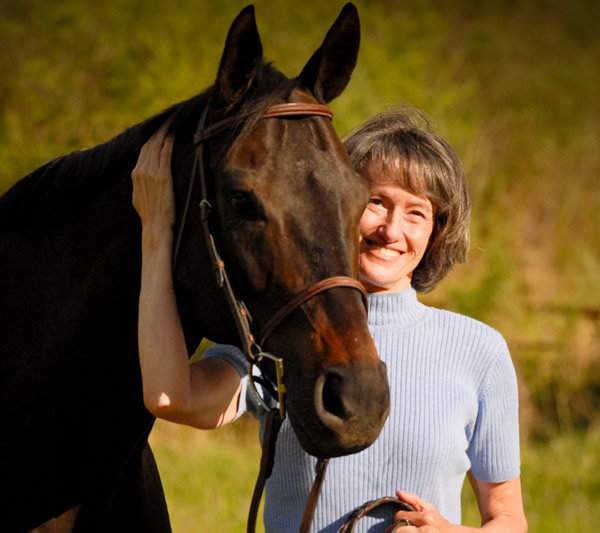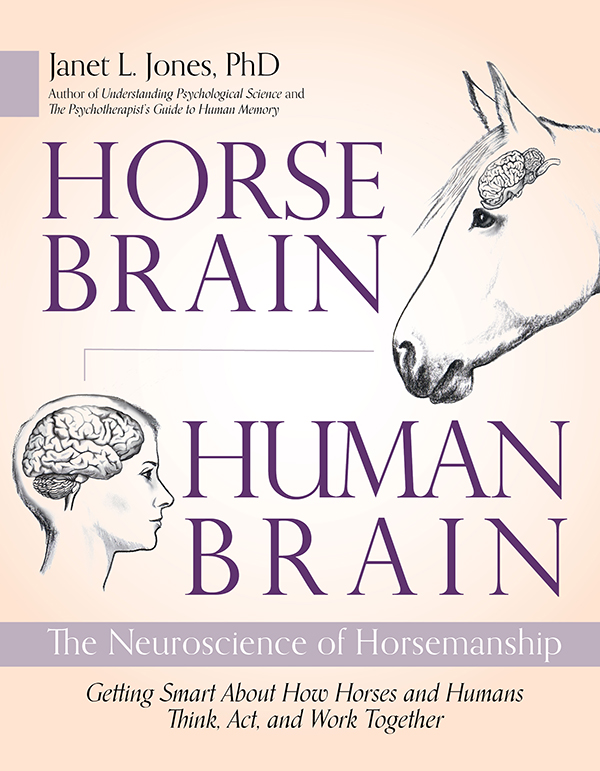TRUE TRAINING 108 - Adopt the Horse's Body Language
Feb 15, 2025 by Janet Jones
True has been trained—and still is—largely by groundwork in which human body language matches equine body language as closely as possible. For example, suppose two horses are on their own out in a pasture, with no pesky humans around. Horse A places his body at a very specific location with respect to Horse B. Then, when Horse A moves slightly forward toward B’s hip, B understands that he is to move forward too. If Horse A moves in toward Horse B’s side, B will step away slightly, also to the side. And so on.
We use the same body language when teaching a horse to move sideways. When I want True to move to the left, I press the right side of his body with my hand. He yields to my touch just as he would yield to another horse, and moves to the left. By using movements that mimic equine body language, we make learning much easier for our horses than when we offer arbitrary non-equine signals.
Later, when we are mounted, we teach green horses that the same pressure—now conveyed by the leg instead of the hand—signals sideways movement. You can apply this to any maneuver that a horse must learn, although of course some are easier to signal than others. At this point, all I need to do is stand within 5 feet of True’s right hip and touch my flat hand to his side. He moves his hindquarters to the left immediately. From there, it’s easy to get him to move his hindquarters to the left while mounted. I simply press behind the girth with my right leg, using similar pressure, gradation, and location.
Often, I see trainers use gestures, movements, and body locations that oppose the horse’s natural body language. For example, during groundwork, some people raise one arm straight over their heads to signal a sidepass. The horse will learn whatever gesture garners a reward, of course, but it’s a mystery why we wouldn’t save time and make the job easier for the animal by using a gesture that is known to horses from their earliest months. After all, horses are the elite masters of body language; we humans are just playing catch-up.
In this example, the raised arm takes longer to teach because it is not natural. It also is ambiguous since people raise their arms toward horses for many purposes. A raised arm could mean “move away” or “stop” or “go faster” or “hold still while I ‘desensitize’ you,” or any number of other things. It’s not one distinctive equine-based signal for one particular maneuver.
When teaching a horse to sidepass from the ground, start by moving just one of the horse’s shoulders or hips. When the horse has learned that, try facing the middle of his side about halfway between his shoulder and hip. Gently press with one hand just behind the area where a saddle cinch or girth typically rests. Continue touching and releasing repeatedly if the horse doesn’t understand what you want him to do. Cluck if you have to, but remain gentle. Eventually, he will take one step sideways—even maybe by mistake. Reward that movement, and you are on your way to a hand signal that will translate very easily to your legs when the horse is working under saddle.
We use the same body language when teaching a horse to move sideways. When I want True to move to the left, I press the right side of his body with my hand. He yields to my touch just as he would yield to another horse, and moves to the left. By using movements that mimic equine body language, we make learning much easier for our horses than when we offer arbitrary non-equine signals.
Later, when we are mounted, we teach green horses that the same pressure—now conveyed by the leg instead of the hand—signals sideways movement. You can apply this to any maneuver that a horse must learn, although of course some are easier to signal than others. At this point, all I need to do is stand within 5 feet of True’s right hip and touch my flat hand to his side. He moves his hindquarters to the left immediately. From there, it’s easy to get him to move his hindquarters to the left while mounted. I simply press behind the girth with my right leg, using similar pressure, gradation, and location.
Often, I see trainers use gestures, movements, and body locations that oppose the horse’s natural body language. For example, during groundwork, some people raise one arm straight over their heads to signal a sidepass. The horse will learn whatever gesture garners a reward, of course, but it’s a mystery why we wouldn’t save time and make the job easier for the animal by using a gesture that is known to horses from their earliest months. After all, horses are the elite masters of body language; we humans are just playing catch-up.
In this example, the raised arm takes longer to teach because it is not natural. It also is ambiguous since people raise their arms toward horses for many purposes. A raised arm could mean “move away” or “stop” or “go faster” or “hold still while I ‘desensitize’ you,” or any number of other things. It’s not one distinctive equine-based signal for one particular maneuver.
When teaching a horse to sidepass from the ground, start by moving just one of the horse’s shoulders or hips. When the horse has learned that, try facing the middle of his side about halfway between his shoulder and hip. Gently press with one hand just behind the area where a saddle cinch or girth typically rests. Continue touching and releasing repeatedly if the horse doesn’t understand what you want him to do. Cluck if you have to, but remain gentle. Eventually, he will take one step sideways—even maybe by mistake. Reward that movement, and you are on your way to a hand signal that will translate very easily to your legs when the horse is working under saddle.

